
Hyde Bank Tunnel
This tunnel is the second of the three original tunnels on the Peak Forest Canal and it is situated in Romiley.
It is 308-yards long by 16-feet wide, so boats could pass, and the minimum height above water level is 6 feet 8 inches.
Boats were propelled through it by 'legging'. If a boat were being operated single-handedly,
the boatman would lie on his back on top of the cabin and 'walk' along the tunnel roof. If two crew members were available, they would place a plank across the boat,
lie on that, back-to-back, and then they would 'walk' along the tunnel sides. Meanwhile, the horse found its own way over the top of the tunnel, a distance of about ½ mile.
Towing horses knew the way and they went over on their own. It was once said that anyone with a good memory had a 'memory like a boat horse'.
Originally, the horse path over the top was known as the 'perpetual easement for horses for canal purposes'.
From the western side of Hyde Bank the horse path climbs up the hill and almost immediately passes below a bridge in the Gothic style that carries the drive to Oakwood Hall.
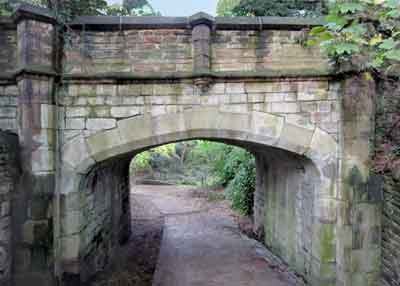
Bridge over the horse path of the Peak Forest Canal at Hyde Bank looking westwards.
This bridge dates from c.1845 and it was built of ashlar and dressed stone with a Tudor arch. The architect was Edward Walters of Manchester who also designed Oakwood Hall and Oakwood Hall Lodge, the latter being adjacent to the bridge on its eastern side. The bridge is listed Grade II, List Entry No. 1242589.
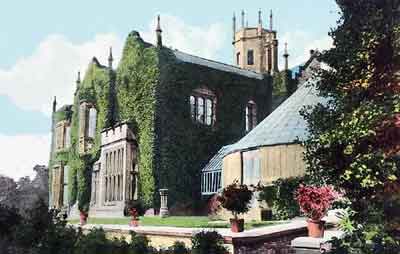
Oakwood Hall, Romiley, early 20th centry.
The hall was built by Edward Walters of Manchester for Ormerod Heyworth (1782-1851), a merchant, whose family was associated with Oakwood Mill close to the western end of Hyde Bank Tunnel.
It was a magnificent mansion built in the Tudor style and the architect was Edward Walters of Manchester. It had panelled walls hung with tapestries, painted ceilings and gold-leaf cornices.
There were formal Italian gardens as well as a landscaped woodland garden that extended down to the river Goyt.
Eventually the hall fell into disrepair and was damaged by vandalism and fire. In the 1970s it was bought by a builder who reduced it to one storey high. Since then it has been rebuilt for use as apartments.
Tunnel Roof Collapse in 1895
This roof collapse at Hyde Bank Tunnel occurred on the 28 Feb 1895 and in order to have it repaired as quickly as possible
the canal management recruited a number of unemployed coal miners. At this time, business was slack at neighbouring coal mines and the men, at least,
would all have had considerable experience of working underground.
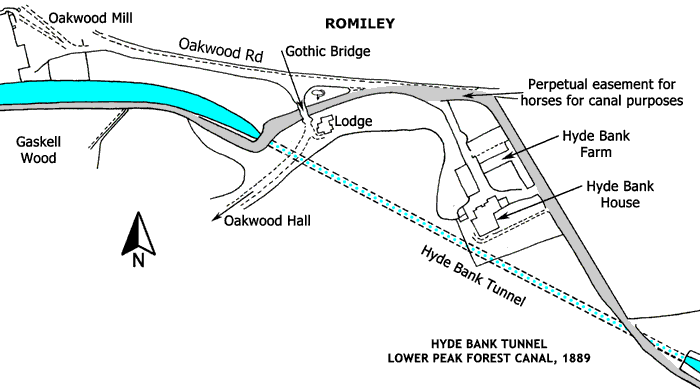
However, management had little experience of these matters and it was concluded that this work could be undertaken without draining the water from this section of the canal. Consequently, it was arranged that a number of maintenance boats were to be floated into the tunnel so that planks could be laid along them. The proposal was that workmen would first barrow spoil from the blockage along the planks for disposal and then effect the necessary repairs to the roof. This plan was ill fated for as the spoil was being removed the roof began to fall even more. Eventually a crater appeared in the ground immediately above the roof collapse that threatened the safety of Hyde Bank House, one corner of which was only a short distance away from the line of the tunnel.
At this juncture all work was stopped as it had become apparent to inspectors that this method of working was not going to succeed. It was suggested that a Mr Hirst, who lived at Dukinfield, should be approached as it was known that he had gained considerable experience of tunnelling while working on the construction of the long railway tunnel at Standedge Following protracted negotiations Mr Hirst finally agreed to take charge of the work on the understanding that he was to be given a free hand with the planning and implementation of the work. The energetic Mr Hirst then set about his task with a will.
His first directive, which was viewed with dismay by the management, was that this section of canal must be drained to remove all water from the tunnel. He then arranged for a special trainload of timber to be delivered to the site, as it was fortuitous that a railway line was quite close to the canal on the north side. This directive must have rankled the management as the rival Sheffield and Midland Railway Company owned the line. Despite this, the workmen under Mr Hirst's direction were successful in shoring up the tunnel lining and removing the blockage without causing additional roof falls.
Following on from this achievement, the management persuaded Mr Hirst to proceed with the work by completely relining the tunnel with bricks. Mr Hirst agreed on the same conditions as before; he was to be given a free hand. Under his directions this work commenced at the south-east portal of the tunnel (Marple end) with the intention of completing the work at the north-west portal (Romiley end). Regrettably, there was a predicament in that management insisted that this section of the canal must be re-watered to permit regular traffic to use the canal at the same time as the tunnel was being relined.
This would seem to be an almost impossible brief and by now communications between Mr Hirst and management were becoming strained to say the least. In spite of the difficulties imposed on him Mr Hirst devised a method of doing the task and work commenced. When the tunnel had almost been completely relined a disagreement arose between Mr Hirst and the management that resulted in Mr Hirst's resignation never to return. His resignation left its mark on Hyde Bank Tunnel in that a short length of the lining at the north-west end was left in the original stone. The course of events following Mr Hirst's resignation can only be speculative but there seem to be three possibilities:
Management decided that enough work had already been done on the tunnel.
Management were unable to replace Mr Hirst.
The workmen followed Mr Hirst and could not be replaced.
The events at Hyde Bank Tunnel must be viewed with the knowledge that the Peak Forest Canal was then railway owned and that management were aware that the canal era was rapidly drawing to a close. The railway network was still being developed and uneconomical wages were being paid to boatmen and canal maintenance staff alike. These factors all took their toll and moreover there was a new threat as road transport was beginning to be developed. The immediate impact of all this was a rapid decline in canal maintenance standards.
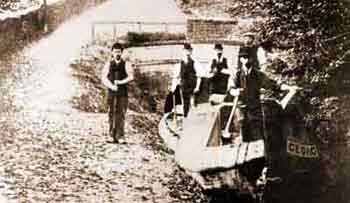
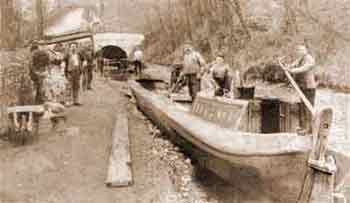
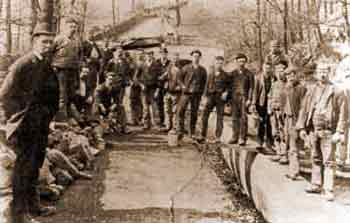
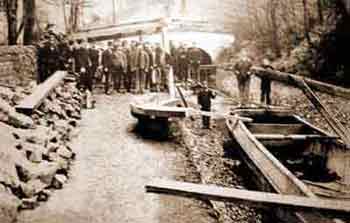
Rose Hill Tunnel
This tunnel was the last of the three original tunnels on the Lower Peak Forest Canal. It was 100-yards long with a towpath through it but boats could not pass.
Because of its proximity to Marple Aqueduct this tunnel was sometimes referred to as Aqueduct Tunnel and another name used was Mancomb Tunnel.
The section of canal between the tunnel and the aqueduct was known as Aqueduct Basin.
In 1833, a major earth slip occurred near Rose Hill Tunnel, known as the Gaskell Wood Slip. This necessitated some bank reconstruction and the building of supports to counter any further slips. However, this was a sign of worse to come. A tithe map of 1849 shows the tunnel was still extant in that year. At an unrecorded date between 1849 and 1888 the tunnel roof collapsed and the damage was so extensive that it was decided to open it up and make a cutting. The opened out tunnel is now known as Rose Hill Cutting.
The tithe map does not show Occupation (or Mancomb) Bridge (No. 15) abutting the west portal of the tunnel but it is understood that it was contemporary with the construction of the canal, dating from 1804. This bridge was provided for the benefit of the local farmer to give him continuity of access to his fields.
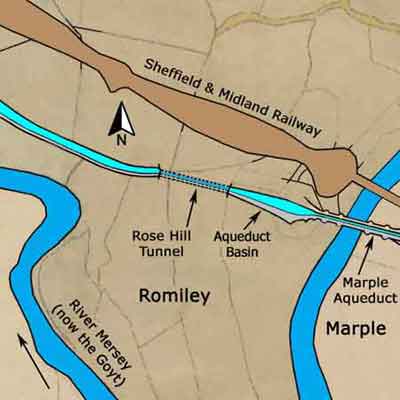
Rose Hill Tunnel
Lower Peak Forest Canal
Grid Ref: SJ 953 900
Tithe Map: 1849, Ref: EDT 341/2
Courtesy: Cheshire Archives & Local Studies
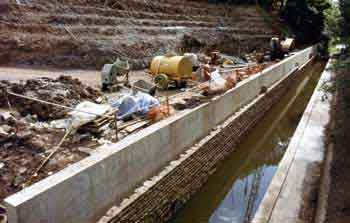
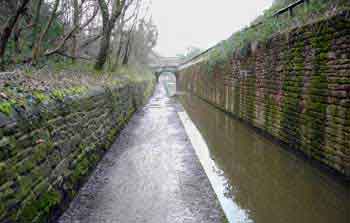
Rose Hill Cutting undergoing repairs, 1997.
The gradient of the cutting is being reduced on the north side and a concrete retaining wall has been constructed to withstand ground pressure from the hillside. This photograph shows the concrete wall being faced with stone.
Rose Hill Cutting, Feb 2006.
Occupation Bridge can be seen in the background.
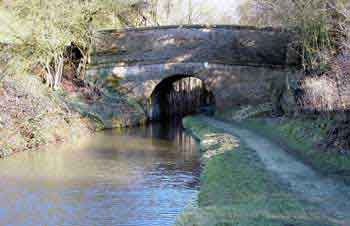
Occupation Bridge, Feb 2006.